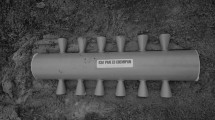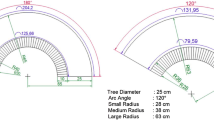Abstract
Pine processionary moth is one of the most important forest pests in the Mediterranean Basin. There is need to explore its distribution behaviour to undertake effective control and determine the edge effect of its horizontal distribution in the stand. Five trial sites damaged by the insect were selected and traps installed in all trees in the sites. The number of nests and larvae was counted and diameter increment cores were taken. The distance to the edge of the stand revealed that there was no statistical difference in the number of nests and larvae up to 25 m while there was a statistically significant difference (0.5%) at > 25 m. There was a 2-fold difference in the density of nests between 0 and 25 m and > 25 meters, and a 3.8-fold difference in the number of larvae. The effect of pine processionary moth on tree diameter was not significant between trees at the edge of the stand and those in the stand.



Similar content being viewed by others
References
Abrol DP, Shankar U (2012) İntegrated Pest Management, Principles and Practice. CABI, Nosworth Way Wallingford Oxfordshire, Oxfordshire, p 513
Akay MS (2014) Kızılçam meşcerelerinde çamkeseböceği’nin populasyon yoğunluğu üzerine etki eden faktörlerin araştırılması. Yüksek Lisans Tezi, Kastamonu Üniversitesi Fen Bilimleri Enstitüsü, p 59
Akbulut S, Yüksel B, Keten A (2002) Çamkese böceğine (Thaumetopoea pityocampa Schiff.) karşı Düzce Orman İşletme Müdürlüğü’nde feromon tuzağı ile yapılan ön denemelerin sonuçlarının incelenmesi, Kahramanmaraş Sütçü İmam Üniv., Orman Fak., Ülkemiz Ormanlarında Çam Keseböceği Sorunu ve Çözüm Önerileri Sepozyumu” Bildiri Kitabı, Kahramanmaraş, Turkey, p 52–59
Akkuzu E, Selmi E (2002) Thaumetopoea pityocampa (Den. & Schiff.)’ya karşı mikrobiyal savaş yöntemlerinin kullanımı, Kahramanmaraş Sütçü İmam Üniv., Orman Fak., Ülkemiz Ormanlarında Çam Keseböceği Sorunu ve Çözüm Önerileri Sepozyumu Bildiri Kitabı, Kahramanmaraş, Turkey, p 67–74
Altunışık A (2015) Isparta yöresi çam ormanlarında çam keseböceği Thaumetopoea wilkinsoni zararının artım üzerine etkisi. Süleyman Demirel Üniversitesi Fen Bilimleri Enstitüsü, Yüksek Lisans Tezi, p 65
Avcı M (2000) Türkiye’nin farklı bölgelerinde Thaumetopoea pityocampa (Den.Schiff.) (Lep.:Thaumetopoeidae)’nın yumurta koçanlarının yapısı, parazitlenme ve yumurta bırakma davranışları üzerine araştırmalar. Türk Entomoloji Dergisi 24(3):167–178
Breuer M, Devkota B, Douma-Petridou E, Koutsaftikis A, Schmidt GH (1989) Studies on the exposition and temperature of nests of Thaumetopoea pityocampa (Den. & Schiff.) (Lep., Thaumetopoeidae) in Greece. J Appl Entomol 107:370–375
Buffo E, Battisti A, Stastny M, Larsson S (2007) Temperature as a predictor of survival of the pine processionary moth in the Italian Alps. Agric For Entomol 9(1):65–72
Çanakçıoğlu H, Mol T (1998) Orman entomolojisi (Genel Bölüm) İ. Ü. Orman Fak. Yayınları Rektörlük Yay. No: 4155, Fakülte No: 455, İstanbul, Turkey, p 541
Castagneyrol B, Régolini M, Jactel H (2014) Tree species composition rather than diversity triggers associational resistance to the pine processionary moth. Basic Appl Ecol 15:516–523
Damien M, Jactel H, Meredieu C, Régolini M, Van Halder I, Castagneyrol B (2016) Pest damage in mixed forests: disentangling the effects of neighbor identity, host density and host apparency at different spatial scales. For Ecol Manage 378:103–110
Dulaurent AM, Porte AJ, Van Halder I, Vetillard F, Menassieu P, Jactel H (2011) A case of habitat complementation in forest pests: Pine processionary moth pupae survive better in open areas. For Ecol Manage 261:1069–1076
Eker M, Çoban OH, Özçelik R, Alkan H, Avcı M (2011) Çam kese böceği yayılışı ile orman yolunun konumsal etkileri arasındaki bağıntının irdelenmesi. Süleyman Demirel Üniversitesi, Orman Fakültesi, Türkiye 1. Orman Entomolojisi ve Patolojisi Sempozyumu Bildiriler Kitabı, Isparta, Turkey, p 234
Erkan N (2011) Impact of pine processionary moth (Thaumetopoea wilkinsoni Tams) on growth of Turkish red pine (Pinus brutia Ten.). Afr J Agric Res 6(21):4983–4988
Güner ŞT, Çömez A (2017) Biomass equations and chances in carbon stock in afforested black pine (Pinus nigra Arnold. Subsp. Pallasiana (Lamb.) Holmboe) stands in Turkey. Fresenius Environ Bull 26:2368–2379
Hódar JA, Zamor G (2004) Herbivory and climatic warming: a Mediterranean outbreaking caterpillar attacks a relict, boreal pine species. Biodivers Conserv 13:493–500
İpekdal K (2005) Çam kese böceği (Thaumetopoea pityocampa Denis. & (Schiffermüller, 1775) Lepidoptera: Thaumetopoeidae’ nın biyolojisi ve mücadelesi üzerine araştırmalar. Yüksek Lisans Tezi, Hacettepe Üniversitesi Fen Bilimleri Enstitüsü Biyoloji Anabilim Dalı, Ankara, Turkey, p 135
Keten A, Akbulut S, Kahraman Z (2010) Düzce’de bazı konukçu ağaç özelliklerinin çam keseböceğinin yumurta koyma yeri tercihleri üzerine etkileri. Düzce Üniversitesi Ormancılık Dergisi 6(1):12–19
Markalas S (1989) Influence of soil moisture on the mortality, fecundity and diapause of the pine processionary moth (Thaumetopoea pityocampa Schiff.). J Appl Entomol 107(1–5):211–215
Ölmez SG (2015) Isparta çam ormanlarında çam keseböceği Thaumetopoea wilkinsoni’nin yumurta bırakma davranışları ve yumurta koçanlarının yapısı. Yüksek Lisans Tezi, Süleyman Demirel Üniversitesi Fen Bilimleri Enstitüsü, p 50
Pimental C, Calvão T, Ayres MP (2011) Impact of climatic variation on populations of pine processionary moth Thaumetopoea pityocampa in a core area of its distribution. Agrıcultural and Forest Entomology 13(3):273–281
Régolini M, Castagneyrol B, Mercadal AMD, Piou D, Samalens JC, Jactel H (2014) Effect of host tree density and apparency on the probability of attack by the pine processionary moth. For Ecol Manage 334:185–192
Ronnas C, Larsson S, Pitacco A, Battisti A (2010) Effects of colony size on larval performance in a processionary moth. Ecological Entomology. 35(4):436–445
Samalens JC, Rossi JP (2011) Does landscape composition alter the spatiotemporal distribution of the pine processionary moth in a pine plantation forest? Popul Ecol 53(2):287–296
Schimitschek E (1953) Türkiye Orman Böcekleri ve Muhiti, Türkiye Orman Entomolojisinin Temelleri (Çev. A. Acatay). İstanbul Üniv. Yayın No: 556, Or. Fak. Yay.No: 24, İstanbul, Turkey, p 471
Speight MR, Wainhouse D (1989) Ecology and management of forest insects. Clarendon Press, Oxford, p 374
SPSS Inc. (2015) SPSS 22.0 Guide to data analysis, Published by Prentice Hall, Upper Saddle River, New Jersey, USA, p 637
Ünal S, Akay MS, Karadeniz M (2014) kızılçam meşcerelerinde çam keseböceği’nin popülasyon yoğunluğu üzerine etki eden faktörlerin araştırılması, Türkiye 2. Orman Entomolojisi ve Patalojisi Sempozyumu Bildiriler Kitabı, Bartın, pp 301–309
Acknowledgements
This study was supported by The Scientific and Technological Research Council of Turkey, (TUBİTAK) Project No. 112 O 250.
Author information
Authors and Affiliations
Corresponding author
Additional information
Project funding: The present study was supported by The Scientific and Technological Research Council of Turkey, (TUBİTAK) (Grant No. 112 O 250).
The online version is available at http://www.springerlink.com
Corresponding editor: Chai Ruihai.
Rights and permissions
About this article
Cite this article
Parlak, S., Özçankaya, İ.M., Batur, M. et al. Determining the edge effect of pine processionary moth (Thaumetopoea pityocampa) in its horizontal distribution in the stand. J. For. Res. 30, 347–352 (2019). https://doi.org/10.1007/s11676-018-0634-5
Received:
Accepted:
Published:
Issue Date:
DOI: https://doi.org/10.1007/s11676-018-0634-5




